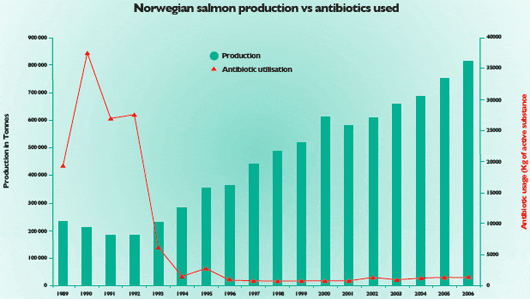Health
Infectious diseases are encountered in all food production. Fish and shellfish may be more under threat from disease than land animals or plants because germs survive longer and can spread more effectively in water. The rapid identification and treatment of bacterial and viral infection is therefore crucial in aquaculture.
National and international regulations have been implemented to approve veterinary medicines that do not compromise food safety. An example of this is the so-called ‘withdrawal period’, defined as the minimum time to elapse between termination of the treatment and harvest of the animal. Withdrawal periods are specific for each drug and each utilisation of that drug, for example to treat bacterial disease.
It is important to note that the use of veterinary medicines such as antibiotics has greatly decreased in many types of aquaculture. For example, in Norway the use of antibiotics in salmon and trout farming has been negligible for the last 10 years due to the use of better vaccines. In 2004, Norway produced 23 times more salmon and trout than in 1985; in the same period, the use of antibiotics dropped by a factor of 25.

Figure 6: Antibiotics used in Norwegian farming of trout and salmon 1980-2004.
With the adoption of tighter laws and regulations, and with the difficulties of drug companies registering new treatments for aquaculture, the availability of medicines to treat aquaculture species becomes increasingly unsure. More and more, research is therefore turning towards prophylaxis as a solution.
Parasites are common in wild fish, too
Parasites are not unique to farmed fish, but in the wild they obviously go untreated. Parasites fall into two main groups – ectoparasites, which affect the skin and external organs, and endoparasites, which invade the body and attack the musculature and internal organs.
Ectoparasites include several types of sea lice, crablike creatures that eat the skin and flesh of the fish. If left untreated, they will cause considerable suffering to the fish and open wounds on the skin of the fish that may become sites for disease.
Endoparasites include nematode worms that enter the body of the fish through the mouth, infest the gut and can then burrow into the flesh of the fish. As well as reducing the fish’s ability to regulate the amount of salt in its body by perforating the gut membrane, they also reduce the saleability of the flesh, since fish infested with nematode parasites are not saleable for human consumption.
As on land-based farms, when animals are held at higher densities parasites can infect a stock relatively rapidly. Because unhealthy fish mean substantial loss to the farmer, however, it is uncommon in modern fish farms to find harmful burdens of parasites. Outbreaks are controlled by modern farming practices and the use of medicines that authorities have deemed safe to the fish, to consumers and to the environment.
Further Reading
| - | You can view the full report by clicking here. |
October 2008

